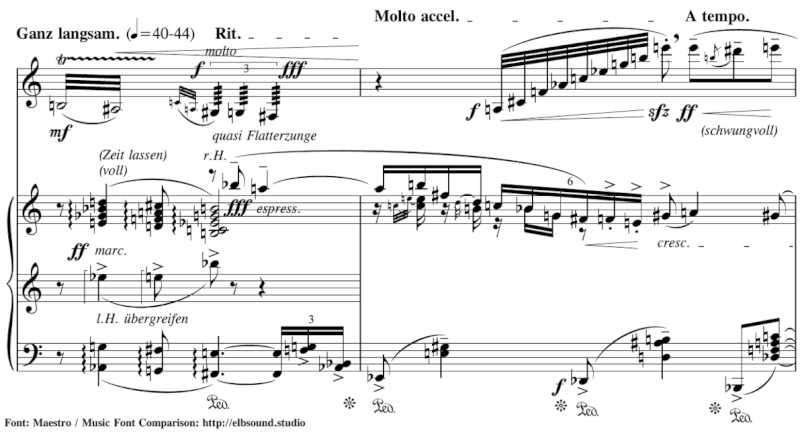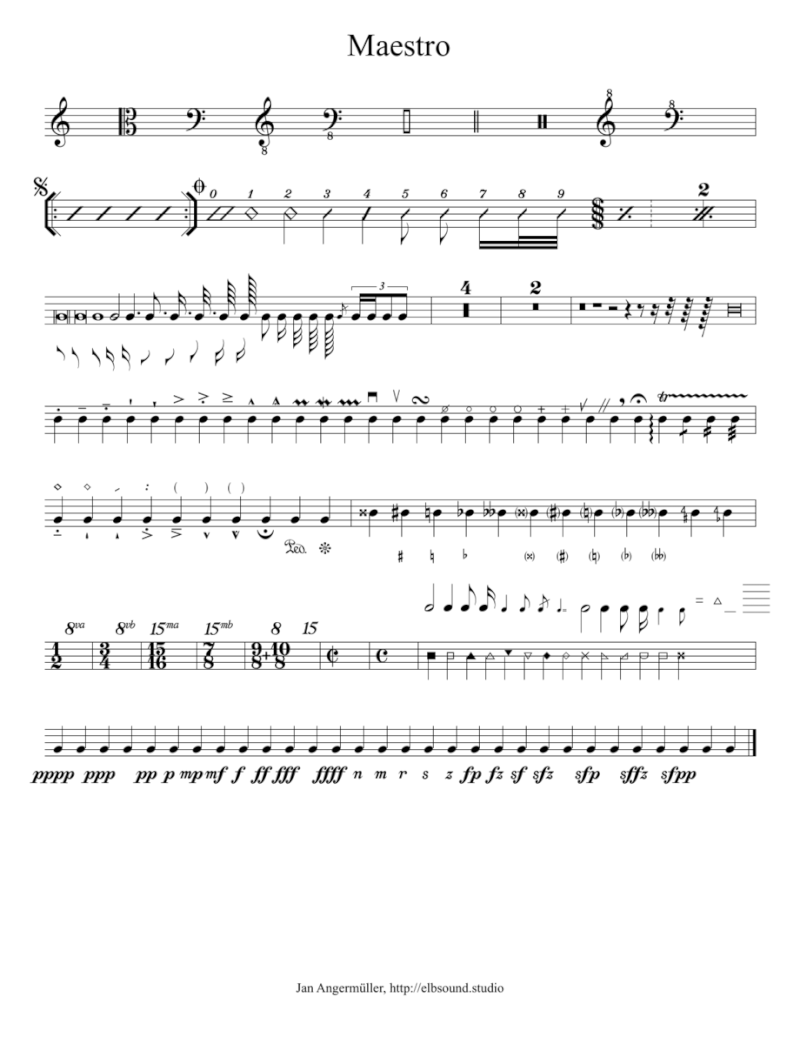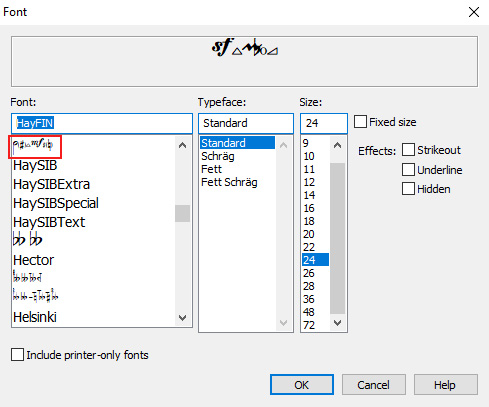Elbsound Finale Fonts Package
(Download 24 Music Fonts for Finale® + Sibelius®)
The
Elbsound Music Fonts Package (v2.93 from 3. February 2022) is a package of
24 music fonts for Finale® and Sibelius®
plus
190 other music fonts that can be used in most notation software (=a total of 214 music fonts,
full list see below).

It's available in our
online shop for just
27,73 USD.
(=25,67 USD net plus 8.02%/2,06 USD taxes).
This animation includes all Finale fonts from the Elbsound Music Font Package and Finale's Maestro:

Download as PDF in high resolution
What makes these music fonts unique?
After the design of the 24 fonts they were converted with Elbsound's own
font conversion software to fully match the metrics and symbols of Finale®'s Maestro font.
Because of this computer-based conversion process the Elbsound music fonts are the only music fonts to be
100% compatible with Finale®'s Maestro. Thus they can also be used in
Sibelius® through its Maestro house style.
They can be applied to a Finale® document with just one click:
simply select "Document->Set Default Music File" in Finale® and ... done.
No extra libraries are needed for metrics adjustment and
no symbols are missing from Maestro!
Free Demo
Here is a
free demo of
the Elbsound Music Font PagniFIN. When using the font in Finale®, make sure to
install the Finale® font annotation files as described in the Read Me.txt - otherwise the font won't work.
This is how PagniFIN
looks in Finale.
Full Contents of the Elbsound Music Fonts Package v2.93:
-
24 fully Maestro-compatible music fonts for use in Finale and Sibelius in TTF and OTF format (the "Elbsound Music Fonts")
(Aruvarb, BetvnFIN, CadncFIN, EmntlFIN, EuterpeFIN, FreeSerifFIN, GldngFIN, GnvilFIN, GotvlFIN, GtbrgFIN, HayFIN, ImprvFIN, JzBscFIN, LeipFIN,
LiJazFIN, MusicaFIN, NotSnsFIN, PrfndFIN,
PagniFIN, RoFIN, SbstnFIN, ScrltFIN, SymbolaFIN and Unifont UpperFIN)
For installation in Sibelius please read our Sibelius installlation tutorial.
More example images of these fonts are available in our Online Music Font Comparison
-All font annotation files for Finale® for these 24 fonts (Sibelius doesn't require font annotation files)
-
190 other music fonts (not fully or not at all compatible with Maestro, but can still be used in Finale and Sibelius or any other notation software that supports third party fonts with individual symbol selection), including Aegean, Alexander, Aloisen GrooveU, AloisenU, Ammerbach, Aroania, Aulos tablature, Avdira, Aybabtu, Beethoven, BMusicFont, BMusicTextFont, Bongos, Bongos2, Bravura, Bravura Text, BravuraMSS, Cadence, Caeciliae Boldstaff, Caeciliae Regular, Caeciliae Staffless, Campania, Cardo, Cleffy, CLicht, cmme, cmme-printer, Code2001, Denemo, Ekmelos, Ekmelos12edo, Ekmelos24edo, Ekmelos72edo, Emmentaler, Euterpe, Extra mensural, feta26, Figurato, FiguratoB, FiguratoMac, Finale Ash, Finale Broadway, Finale Engraver, Finale Jazz, Finale Legacy, Finale Maestro, FreeSerif, FretQwik, FretQwikC, Glyph3 Harp, Glyph3 Synth, Glyph3 Woodwinds, Gonville, Gootville, Gootville Text, GrooveU, Gutenberg-1939, greciliae, greciliae-op, greextra, gregall, gregorio, gregorio-op, gresgmodern, Haydn, HEJI2-Regular, HEJI2, HEJI2Bravura, HEJI2Text, Improviso, JazzyBasic, KhAccidentals, KhAccidentals-InParentheses, KhAccidentals-Twentyfourths, KhReed.Position, KhReed.Position-Tongue, KhReed-Pressure.LipsandAir, KhWoodwindFingeringChart-Divide, KhWoodwindFingeringChart-Holes, KhWoodwindFingeringChart-Levers, Leipzig, Leland, LelandText, Mensural1, Metrico, Mozart, Möller, MScore, MScoreBC, MScoreTablature, MScore Text, Mus6, MusAnalysis, MusFrets, MuseJazz, MuseJazz Text, Musescore Icon Set, MusGlyphs, Musical Symbols, Musica, MusiQwi, MusiQwikB, MusiSync, 21 NAFTracks Flute fingering fonts, New Athena Unicode, Norfolk Harp Std, Norfolk Ornaments Std, NoteHedz, NotoMusic, Noto Sans Symbols, NWslur, parmesan, parmesan-op, PendantOcarina, Petaluma, Petaluma Text, Profondo, Quivira, Ross, Scorlatti, Sebastian (plus 8 Sebastian family fonts), Sebastiano, Symbola, Taneyev Alt1 Std, Taneyev Special Alt1 Std, Taneyev Special Std, Taneyev Std, Taneyev Text Std, TeXLUTE8, TeXLUTE9, TeXMUSIX29, TeXMUSIXSPS, TeXMUSIXSPX, TeXMXSK, TeXXADF29, TeXXGREG29, TeXXPPFF10, TeXXSLD29D, TeXXSLU29, TeXPalladioL-FB and Unifont Upper.
-1-click arpeggio library for Finale® (see
below)
-Large brackets library for Finale® plus the XITS Math font (see
here more info)
-Installation and how to use manual
-Example PDF of all fonts
-PDF with all symbols from all fonts
-10 JW Lua scripts from our
script library (Append Quarter Note in 5/4, Change Chord Gap, Change Noteheads, Make Longa, Remove Hidden Text at End of Expressions, Rmove All Page Breaks, Replace in All Text Blocks, Split Time Sig, Split Multi-Measure Rests, Tremolo Centering)
Note:
The 24 Elbsound FIN fonts are no SMuFl fonts.
They are compatible with the "Maestro" font, but not with the new SMuFl-style "Finale Maestro" font from Finale 27.
This means: the fonts will work fine in any version from Finale 2014 to Finale 27.
However, if you want to use the 24 Elbsound FIN fonts in a
new Finale 27 document, make sure to use the "Maestro Font" template or a similar template, but not the "Finale Maestro Font" template.
System requirements:
Finale® 2014, 2014.5, 25, 26 27 or Sibelius® 6, 7 or 8

Note:
1.) The Music Fonts Package only includes
music symbol fonts! If you're looking for corresponding
text fonts, please look at the
Elbsound Text Fonts Package.
2.) MakeMusic, the makers of Finale®, have confirmed on 2016/10/19 that there is a minor bug in Finale's MacOS font handling which shows the font symbols 128-159 on unicode fonts on MacOS on other symbol slots. All other symbols show up fine on MacOS.
According to Finale's notation product manager Mark Adler this will be "fixed in an upcoming point release".
This bug only occurs on MacOS and only in Finale/MacOS. In other MacOS software or on Windows all symbols work fine.
This means: You can still use ALL symbols of these fonts in Finale/MacOS. But the symbols from slots 128-159 will be visible in other slots.
All Symbols
 Image 2: All Maestro-compatible symbols (created with "Document->Set Default Music Font")
Image 2: All Maestro-compatible symbols (created with "Document->Set Default Music Font")
Usage in Finale®
With the Elbsound font package it just takes 5 seconds.


Make sure to type (!) the Elbsound font name if you want to select it in a Finale dialog, because the font lists in Finale sometimes only show musical symbols from the font and not the font name.
In the image above the font name HayFIN is not readable in the font list.
Usage in Sibelius®
In
Sibelius® the fonts can be used via a house style based on the "Maestro" style.
->
Step-by-step tutorial on how to setup the fonts in Sibelius® (Thanks to Robin Walker for providing this!)

Image 5: Usage in Sibelius® with a "Maestro"-compatible house style: switching back and forth between Helsinki and HayFIN
1-Click Arpeggio with the Elbsound Music Fonts
The Lilypond based fonts in the Elbsound Music Fonts Package have an extra single length arpeggio element in the upper unicode area (symbol U+E15B).
If you use this symbol instead of the standard Maestro-compatible double length element (symbol 103), it's possible get a good arpeggio positioning in Finale® with one click.

Image 6: "Double Length" symbol in Maestro, a few "Single Length" symbols from the Lilypond based Elbsound fonts
To use the library simply assign one of the articulations to an articulation meta tool (Select articulation tool and hold shift and press the meta tool key, then select the articulation definition and hit ok).
To assign the articulation to the note key-click on the note at the
bottom border (!) of the note.
The horizontal position of the arpeggio
only fits quarter notes, but not whole notes, additional accidentals or chords with noteheads on both left and right of the stem.
To also manage the latter with one click, you could create more articulation definitions with slightly bigger horizontal offsets.
This trick only works if the
fonts are not added to MacSymbolFonts.txt! Otherwise the unicode symbol area is not visible.
 Video: 1-Click Arpeggio in Finale® with the Arpeggio Library
Video: 1-Click Arpeggio in Finale® with the Arpeggio Library
FAQ/Troubleshooting
1.) I am seeing weird symbols (letters, signs, etc.) instead of the music symbols.
Make sure you DID'T add the font names to Finale's MacSymbolFonts.txt file.
If you had already added it to MacSymbolFonts.txt, please remove the line(s) AND restart Finale.
2.) Articulations and expressions have a huge distance to the notes
The font annotation (FAN) files are not installed correctly.
Also make sure you restart Finale after installing the FAN files.
3.) Problems with FAN files in Finale
Finale® changes the font annotation format regularly in its updates. Should you encounter any problems with font annotation, it's also possible to auto-create these files from within Finale.
Just go to Preference->Font Annotation, select the font, click on "Auto-annotate all" and then on "Save".
4.) Installation on older Finale® version on Windows
If you are using the fonts on an older Windows installation of Finale, please use the fonts from the MacOS/Fonts folder and also add the font names to the Windows MacSymbolFonts.txt.
The fonts for Finale® were not tested on older installations, so they might not work. Especially the "upper unicode block" fonts (Free SerifFIN, Unifont UpperFIN and EuterpeFIN) might not be available in versions before 2014.
5.) The symbols 129-159 are missing on MacOS.
Yes, this is correct. This happens because of a (confirmed) bug in Finale/MacOS.
Although MakeMusic promised to fix this bug in 2016, they haven't done so yet.
6.) Inconsistens symbols ?
All Finale® fonts were created from the original fonts using the
Experiments in Font Conversion software developed by Elbsound.studio.
No new symbols were designed, but a few composite symbols were derived automatically from existing symbols (e.g. marcato-staccato, tenuto-staccato, ottava clefs, composite dynamics, arpeggio etc.).
If a symbol doesn't match the style of the font (e.g. the niente 'n' in ImprvFIN), it is because a matching symbol was not available in the used fonts.
7.) Combining the Maestro-compatible symbols with the characters from the unicode blocks
On Finale/Windows you also have access to the unicode symbols from these fonts (not on MacOS -> see 2. above).
For example the full Bravura range is available in Aruvarb, or all Lilypond symbols are available in CadncFIN.
But don't forget: these unicode symbols were not rescaled or repositioned, so they might require some fine-tuning if you want to integrate them into your score or match the Maestro-like symbols.
8.) Some flags in the musical example Berg look different than in my own scores.
Yes, some flag settings were optimized for some fonts. Especially those fonts that have very different
metrics than Maestro require a tiny flag optimizaton.
Those are mainly the handwritten fonts. To fine-tune the flag settings go to Document Options->Flags
or use the upcoming House Style Changer plugin which already includes the correct flag settings.
(see
here)
9.) Why are the quarter-tone accidentals different than in Maestro ?
The quarter-tone accidentals in Maestro are very buggy: compared to the standard accidentals they
have a different size, a different design and a different baseline which makes them more or
less unusable (another "confirmed bug").
To have quarter-tone accidentals that can actually be used, we decided to have them match the standard
accidentals in size and baseline, so that they can be easily used in Finale.
Unfortunately some original fonts do not have these "digit 4"-quarter-tone accidentals (e.g. the Cadence font).
In these cases a quarter-tone accidentals from one of the fallback fonts (Bravura, Musica and Symbola)
was used which slightly differs in design.
10.) Which original fonts were used for the Elbsound Music Fonts Package?
The original fonts were released under a SIL OFL or GNU GPL license which allows modification of the fonts and commercial selling.
They were not compatible with Finale® and Sibelius®, so we decided to modify them to match the Finale® specifications.
These fonts were used (in brackets their original encoding):
Bravura font for Finale = Aruvarb (originally made for SMuFL)
Beethoven font for Finale = BetvnFIN (originally made for LilyPond)
Cadence font for Finale = CadncFIN (originally made for LilyPond)
Emmentaler font for Finale = EmntlFIN (originally made for LilyPond)
Euterpe font for Finale = EuterpeFIN (originally made for Unicode)
Free Serif font for Finale = FreeSerifFIN (originally made for Unicode)
Gonville font for Finale = GnvilFIN (originally made for LilyPond)
Gootville font for Finale = GotvlFIN (originally made for MuseScore)
Gutenberg1939 font for Finale = GtbrgFIN (originally made for LilyPond)
LV-GoldenAge font for Finale = GlndgFIN (originally made for LilyPond)
Haydn font for Finale = HayFIN (originally made for LilyPond)
Improviso font for Finale = ImprvFIN (originally made for LilyPond)
JazzyBasic font for Finale = JzBscFIN (originally made for MuseScore)
Leipzig font for Finale = LeipFIN (originally made for SMuFl)
Musica font for Finale = MusicaFIN (originally made for Unicode)
Noto Sans Symbols font for Finale = NotSnsFIN (originally made for Unicode)
Profondo font for Finale = PrfndFIN (originally made for LilyPond)
Paganini font for Finale = PagniFIN (originally made for LilyPond)
Ross font for Finale = RoFIN (originally made for LilyPond)
Scorlatti font for Finale = ScrltFIN (originally made for LilyPond)
Sebastiano font for Finale = SbstnFIN (originally made for LilyPond)
Symbola font for Finale = SymbolaFIN (originally made for Unicode)
Unifont Upper font for Finale = UnifontUpperFIN (originally made for Unicode)
11.) Can I exchange Finale documents with the fonts between MacOS and Windows ?
Yes. You should only make sure that either the MacOS fonts are installed on both OS
(see Installation on MacOS & Windows above).
Or you should only use the symbols 32-255, but no upper unicode symbols (256 and above)
as these are not available on the MacOS fonts.
To avoid problems you should embed the fonts in PDFs if they will be viewed cross-platform.
12.) What is the "Elbsound font package arpeggio.lib"?
It's a library for using the Elbsound arpeggio symbols with 1-click for any chord.
See
arpeggio
13.) Is it possible to use the fonts in Finale 2012 or older versions?
This might be possible, but with limitations as older versions of Finale didn't support unicode symbols.
Also the font annotation files might not be compatible.
14.) Systems tested
Finale's font handling depends on the operating system (MacOS or Windows), its version and Finale's version.
The fonts were tested on Windows 10 with Finale 2014, 2014.5, 25, 26 and 27.
 It's available in our online shop for just 27,73 USD.(=25,67 USD net plus 8.02%/2,06 USD taxes).
It's available in our online shop for just 27,73 USD.(=25,67 USD net plus 8.02%/2,06 USD taxes).







